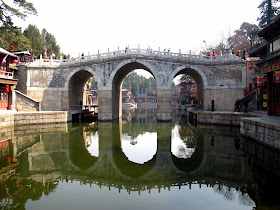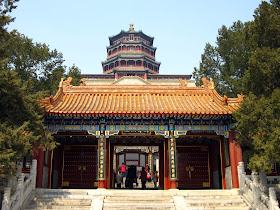Suzhou Market Street (Suzhoujie, 苏州街)
If you travelled to Yíhé Yuán by subway, you will end up entering via North Palace Gate (Beigongmen, 北宫门) like us and start your way from Suzhou Market Street.
This are is named as Suzhou Market Street simply because it was constructed to mimic the market street in Suzhou. It was said that when the imperial family were there, maids, etc would act as peddlars or shop keepers of those shops. I wonder if they kept the 'acting' real, including paying for the things they purchase. Most of the shops are either souvenir shops or eateries.
 |
| 葫芦 (húlu), wiki said it is call Calabash in English (I didn't know prior to this) - we thought they were edible fruit (if it was we would have bought it to try) but was told these were toys. |
Hall of the Sea of Wisdom (Zhihuihai, 智慧海)
 |
| Front gate |
On the slope north of the Tower of Buddhist Incense (the next site), or behind the tower, depending on which gate you get in the complex, sits the green and yellow brick and tile 18th century Hall of the Sea of Wisdom. Technically, we reached this Hall prior to the Tower of Buddhist Incense.
Each archway/gateway has a different characters at the top. The one on the front side showed Zhong Xiang Jie (Realm of Multitudinous Fragrance, 众香界), the 3 archways at the back each showed different characters. The one on the photo showed Ji Xiang Yun (Auspicious Cloud, 吉祥云). This hall housed a statue of Guanyin (the Goddess of Mercy).
Tower of Buddist Incense (Foxiangge, 佛香阁)
The highest building in Summer Palace, one finds the prominent, octagonal Tower of Buddist Incense or some books refer it as Tower of the Fragrance of the Buddha (Foxiangge, 佛香阁) standing atop the Longevity Hill.
This tower was destroyed, and rebulit during the reign of Emperor Guangxu. Of note, this was where Emperor Dowager Cixi prayed and burned joss sticks on the first and fifteenth day of each lunar month. A statue of the thousand-handed Guanyin Buddha, cast in bronze and gilded with gold stands inside the tower.
Even for someone like me with almost non existence knowledge in China history, I find this tower really did stood out amongst the rest of the buildings.
Staring down from this tower, we found the buildings in the centre has orange, or yellow roofs.
Hall of Dispelling Clouds (Paiyundian, 排云殿)
This hall was initially the Hall of the Great Buddha of the Temple of Immense Gratitude and Longevity (Da Baoen Yanshou Shi Da Xiongbao Dian, 大报恩延寿寺大雄宝殿). [phew, that's a mouthful!].
It was built by Emperor Qianlong as a gift for his mother's 60th birthday. It was burnt down by the Anglo-French Allied Forces in 1860 and rebuilt during the reign of Emperor Guangxu as a place to celebrate Empress Dowager Cixi's birthdays.
Long Gallery/Corridor (Changlang, 长廊)
Longest corridor (728 meters) in Chinese classic gardens with different painted stories for every single beam. I overheard a tour guide said one of the painting was on Monkey King. I can't attest to that as I was not able to locate that one.
It was said that the corridor was initially built by Emperor Qianlong for his mother so that she could enjoy the garden regardless of weather.
Marble Boat (Shifang, 石舫)
This western design boat was often associated with Empress Dowager Cixi, in a not so good way in my humble opinion. Reason being this boat was financed with funds meant for the modernization of the Imperial Navy. Far from any use to the Imperial Navy, this boat was used to enjoy the lake view with a cuppa tea.
It was not made with marble, but of wood but painted white to look like marble. The boat is now the only western-style structure in Summer Palace.
Seventeen-Arch Bridge (Shiqikong Qiao, 十七孔桥)
This bridge was built to connect the eastern shore of Kunming Lake and South Lake (Nanhu) Island.
I don't have a lot of photos on this bridge, as I kind of cheated on this one - viewing from afar. Then again, if we were to walk to near, it would be hard to capture all the seventeen arches, no? Grin.
Hall of Benevolence and Longevity (Renshoudian, 仁寿殿)
The principal ceremonial hall houses the throne upon where Cixi sat. According to this very informative website, the pair of bronze statues - dragon and phoenix were used as incense burners to perfume the air on formal occasions.
The phoenix statue as opposed to dragon (representing the Emperor) was placed in the centre of the courtyard, representing Cixi who managed the affairs of the state.
Garden of Harmonious Pleasures (Xiequ Yuan, 谐趣园)
Save the best for last. I like this garden in particular, maybe given its location, I find it significantly quieter compared to the rest of the grounds, since hordes of tourists visit Summer Palace.
 |
| Abundance of fishes |
This was modeled on the famous Jichang Garden in Huishan, Wuxi (Jiangsu Province). Therefore it was first known as Huishan Garden prior to refurbishment during the reign of Emperor Jiaqing. Emperor Jiaqing renamed this garden, to its current name based on a poem by Emperor Qianlong. This garden is well known as the "garden within a garden"
P/S: I read up a few websites here and there and book to summarize the above, though primarily thanks to this site. Maybe next up I shall just post up the photos and said, refer here for details. ^ ^





















.JPG)
